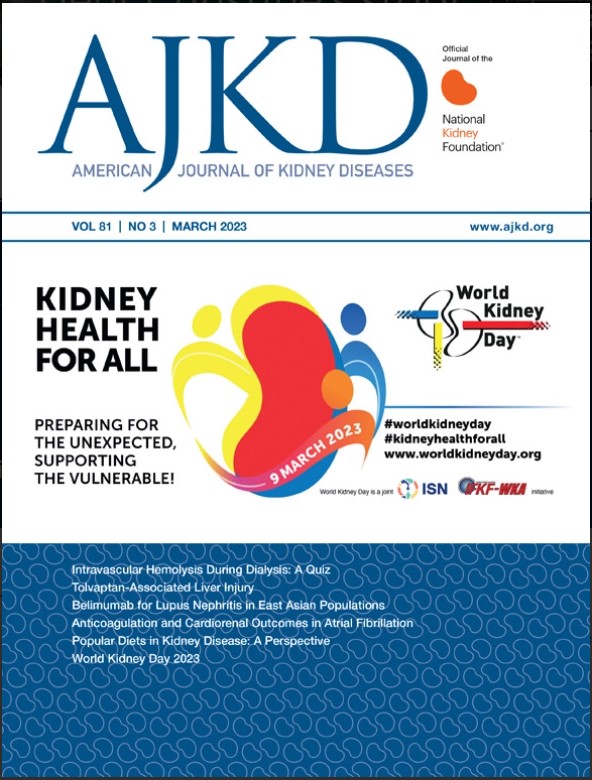家庭透析治疗吸收的患者和中心因素:英国肾脏登记队列和国家透析中心调查分析。
IF 8.2
1区 医学
Q1 UROLOGY & NEPHROLOGY
引用次数: 0
摘要
理由与目的不同中心和地区家庭透析治疗(HT)使用的差异可能反映了透析中心服务与患者特征之间的相互作用。我们在英国研究了这些因素与HT摄取之间的直接和间接关联。研究设计:英国肾脏登记(UKRR)队列与全国肾脏中心调查相关。背景和参与者:2015年至2019年期间在51个英国肾脏中心开始肾脏替代治疗(KRT)的成年人,通过UKRR确定的总计32400人,中心实践来自2022年全国透析中心调查。exposure -(人口统计学和临床特征)和中心水平(包括辅助腹膜透析的可用性、质量改进举措和促进员工参与研究)因素。结果:开始KRT后一年内使用HT(家庭血液透析或腹膜透析)。分析方法回归序列是通径分析的延伸,用于检查患者和中心水平因素与HT摄取概率之间的直接和间接关联。结果中心和患者水平的因素均与HT摄取概率有显著相关。在开展质量改进项目(OR [95% CI])、提供辅助PD(1.89,[1.39-2.57])、促进员工研究参与(1.35,[1.03-1.77])或主持HT路演(1.22,[1.05-1.41])的中心,患者接受HT的几率更高。对员工提供高温疗法能力压力较大的中心,其吸收率较低(0.60,[0.45-0.81])。KRT开始时移植名单上的患者(2.55,[2.35-2.77])或离治疗中心较远的患者(每10公里1.10,[1.08-1.12])有较高的HT摄取几率。生活在高剥夺地区或少数民族的患者总体上有较低的羟色胺摄取。然而,在服务于更多样化人群的中心,其中一些关联可能已经间接减轻,因为这些中心更有可能实施与更高的高温疗法摄取相关的做法。医疗保健专业人员报告和汇总的调查数据。结论本研究确定了与高温疗法摄取相关的可改变的中心水平因素,为减少种族和地区水平差异提供了潜在的机会。本文章由计算机程序翻译,如有差异,请以英文原文为准。
Patient and Center Factors in Home Dialysis Therapy Uptake: Analysis of a UK Renal Registry Cohort and a National Dialysis Center Survey.
RATIONALE & OBJECTIVE
Variation in home dialysis therapy (HT) use across centers and geography may reflect the interplay between dialysis center services and patient characteristics. We examined direct and indirect associations between these factors and HT uptake in England.
STUDY DESIGN
UK Renal Registry (UKRR) cohort linked to a national survey of renal centers.
SETTING & PARTICIPANTS
Adults who initiated kidney replacement therapy (KRT) between 2015 and 2019 at 51 English renal centers, totalling 32,400 individuals identified through the UKRR, with center practices captured from a 2022 national survey of dialysis centers.
EXPOSURES
Patient- (demographics and clinical characteristics) and center-level (including availability of assisted peritoneal dialysis, quality improvement initiatives, and fostering staff engagement in research) factors.
OUTCOMES
Use of HT (home haemodialysis or peritoneal dialysis) within one year of starting KRT.
ANALYTICAL APPROACH
Sequences of regressions, an extension of path analysis, used to examine direct and indirect associations between patient- and center-level factors and the probability of HT uptake.
RESULTS
Both center- and patient-level factors were significantly associated with the probability of HT uptake. Patients at centers conducting quality improvement projects, (OR [95% CI]) 1.94, [1.36-2.76]), offering assisted PD (1.89, [1.39-2.57]), fostering staff research engagement (1.35, [1.03-1.77]) or hosting HT roadshows (1.22, [1.05-1.41]) had higher odds of HT uptake. Centers with greater stress on staff capacity to deliver HT had lower uptake (0.60, [0.45-0.81]). Patients on transplant lists at KRT start (2.55, [2.35-2.77]) or who lived farther from a treatment center (1.10, [1.08-1.12] per 10km) had higher odds of HT uptake. Patients living in areas of higher deprivation or members of minority ethnic groups had lower HT uptake overall. However, some of these associations may have been indirectly mitigated in centers serving more diverse populations, as these centers were more likely to implement practices associated with higher HT uptake.
LIMITATIONS
Healthcare professional-reported and aggregated survey data.
CONCLUSIONS
This study identified modifiable center-level factors associated with HT uptake, informing potential opportunities to reduce ethnic and area-level disparities.
求助全文
通过发布文献求助,成功后即可免费获取论文全文。
去求助
来源期刊

American Journal of Kidney Diseases
医学-泌尿学与肾脏学
CiteScore
20.40
自引率
2.30%
发文量
732
审稿时长
3-8 weeks
期刊介绍:
The American Journal of Kidney Diseases (AJKD), the National Kidney Foundation's official journal, is globally recognized for its leadership in clinical nephrology content. Monthly, AJKD publishes original investigations on kidney diseases, hypertension, dialysis therapies, and kidney transplantation. Rigorous peer-review, statistical scrutiny, and a structured format characterize the publication process. Each issue includes case reports unveiling new diseases and potential therapeutic strategies.
 求助内容:
求助内容: 应助结果提醒方式:
应助结果提醒方式:


